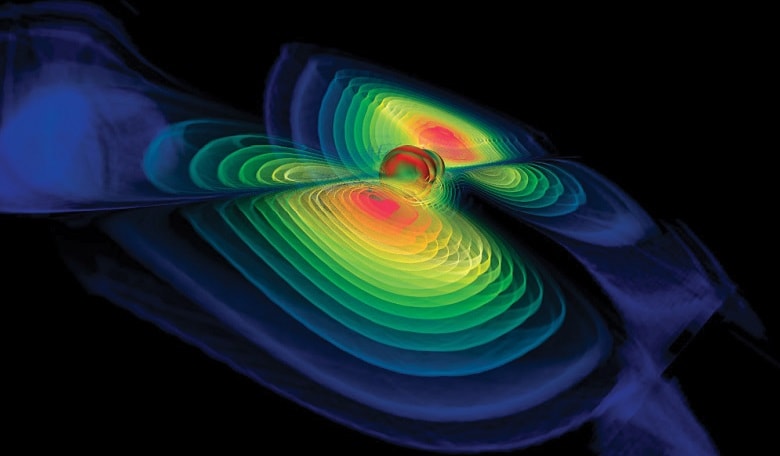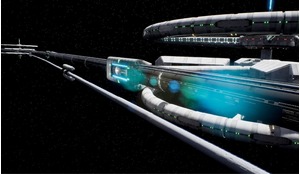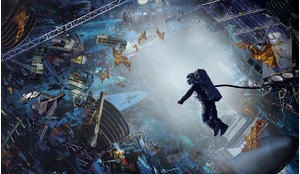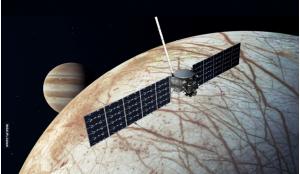On 11 February 2016 a team of scientists from the California Institute of Technology (Caltech), Massachusetts Institute of Technology (MIT) and LIGO (Laser Interferometer Gravitational-Wave Observatory) formally announced the landmark discovery of gravitational waves, or ‘ripples’, in the fabric of space-time caused by the waves from two colliding black holes. The existence of such waves was first predicted by Albert Einstein a century ago but, until last year, scientists had no fool-proof way of testing for their presence. The first measurements, which came through on 14 September 2015, sparked the true beginning of a new area in astrophysics - gravitational wave astronomy - made possible by two major discoveries and revealed by the LIGO team.
First, the direct detection of gravitational waves and, second, confirmation of two merging black holes that produced these exciting waves.
To explain gravitational waves, we need to understand how gravity acts in space. Gravity is the force that keeps us, and everything else, rooted to Earth’s surface and, when applied to our planet, is defined by the laws developed by Sir Isaac Newton. However, in space those laws cannot be applied anymore.
The more massive an object is, the more the fabric of space-time bends
The universe could be likened to a giant rubber sheet where all of the objects within it, such as the planets, stars and galaxies, act as balls making it bend and creating a curvature in space-time. Conversely, the fabric of space-time also guides other objects how to move around this ‘rubber sheet’ as depicted by Earth orbiting the Sun in Figure 1. This is the simplified meaning of the main equation of Einstein’s General Relativity (shown in Figure 2).
The more massive an object is, the more the fabric of space-time bends. Shortly after the prediction of gravitational waves by Einstein, the physicist Karl Schwarzschild proved the existence of black holes. These objects are so compact and dense that no light can escape their gravitational field. Despite the absence of light emitted from black holes, which makes direct observation of these objects impossible, we have already seen multiple effects of black hole candidates on their surrounding environment.
It is through these ‘signposts’ that researchers have detected a supermassive black hole called Sagittarius A* at the centre of our galaxy, millions or billions of times more massive than the Sun.
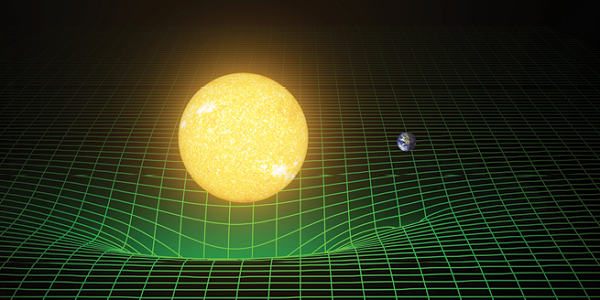 Figure 1: Comparison of Sun and Earth embedding diagram
Figure 1: Comparison of Sun and Earth embedding diagram
Black holes are formed when a massive star explodes in a cataclysmic explosion called a core-collapse supernova. The remnants of these types of dead star will form a black hole of a lower mass: between a few to a hundred times the mass of the Sun. Black holes are the most mysterious objects in the universe and, paradoxically, the simplest: only two characteristics are required to describe them. The first is the mass that will define its size, and the second is the spin that shows how the space-time swirls.
Due to the massive and compact nature of black holes, these objects create a ‘hole’ in the fabric of space-time and when two accelerating massive objects rotate around each other they disturb space-time so much that waves of distorted space radiate from the source. It is these ‘ripples’ of space-time that are detected as gravitational waves. These waves travel at the speed of light carrying information about their progenitor and they can also be produced by other violent events in the cosmos such as the big bang.
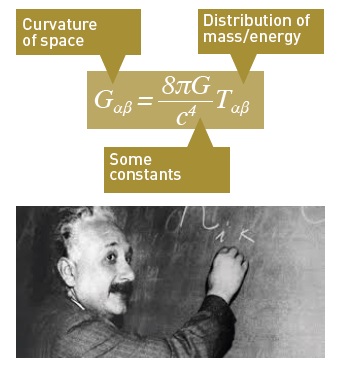 Figure 2: The main equation of Einstein’s General Relativity
Figure 2: The main equation of Einstein’s General Relativity
While the phenomena that produce these waves are generally so massive they are beyond our imagining, the signal they produce is extraordinarily weak. Nonetheless, on the 14 September 2015, the LIGO detected a signal, dubbed GW150914, which not only confirmed the existence of gravitational waves but also the first confirmation of the existence of the merging of two black holes, hence providing a powerful cosmic laboratory for testing Einstein’s theory.
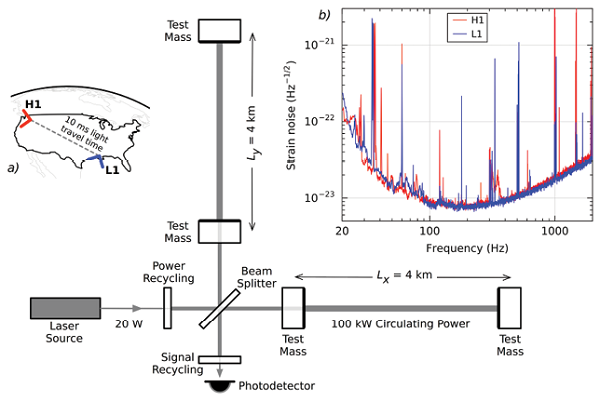 Figure 3: Simplified diagram of an Advanced LIGO detector. The laser source is passing through an optical cavity that reflects the laser light back and forth many times in each arm, multiplying the effect of the gravitational wave on the phase of the laser light; the power recycling mirror produces an increase of the power of the laser and the signal recycling source to obtain an optimised signal in the photodetector. The inset a) shows the locations and orientations of the two LIGO observatories, and indicates the light travel time between them. Inset (b) shows how the instrument strain noise varied with frequency in each detector (Hanford in red and Livingston in blue)
Figure 3: Simplified diagram of an Advanced LIGO detector. The laser source is passing through an optical cavity that reflects the laser light back and forth many times in each arm, multiplying the effect of the gravitational wave on the phase of the laser light; the power recycling mirror produces an increase of the power of the laser and the signal recycling source to obtain an optimised signal in the photodetector. The inset a) shows the locations and orientations of the two LIGO observatories, and indicates the light travel time between them. Inset (b) shows how the instrument strain noise varied with frequency in each detector (Hanford in red and Livingston in blue)
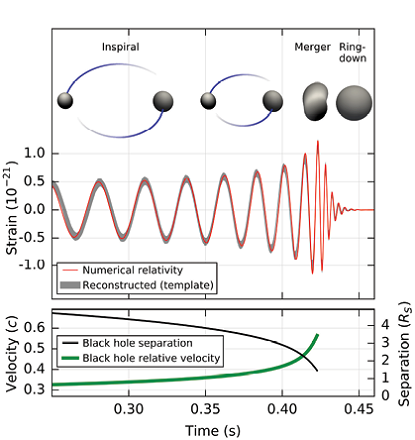 Figure 4: First detection of a gravitational wave by LIGO. The red (top) and blue (bottom) lines show the filtered data collected by the Hanford and Livingston observatories, respectively. The data from each detector is bandpass filtered between 35 Hz and 350 Hz, with additional notch filters used to suppress strong instrumental spectral lines. On the bottom are the separation and velocity of the black holes, and how they change as the merger event unfolds
Figure 4: First detection of a gravitational wave by LIGO. The red (top) and blue (bottom) lines show the filtered data collected by the Hanford and Livingston observatories, respectively. The data from each detector is bandpass filtered between 35 Hz and 350 Hz, with additional notch filters used to suppress strong instrumental spectral lines. On the bottom are the separation and velocity of the black holes, and how they change as the merger event unfolds
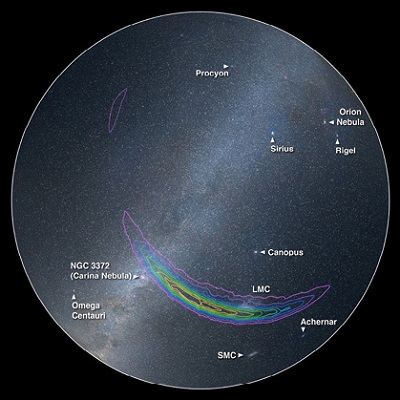 Figure 5: The southern hemisphere where the signal originated from at the time of the event. The position of GW150914 is highlighted by the different colour contours: the highest probability starts in purple and decreases to yellow as the restricted area becomes smaller. A number of common objects in the sky are shown for comparison, with the Sun rising and the Milky Way diagonally from NW to SE. Shane Larson, Northwestern University; Roy Williams, Caltech; Thomas Boch, CDS Strasbourg
Figure 5: The southern hemisphere where the signal originated from at the time of the event. The position of GW150914 is highlighted by the different colour contours: the highest probability starts in purple and decreases to yellow as the restricted area becomes smaller. A number of common objects in the sky are shown for comparison, with the Sun rising and the Milky Way diagonally from NW to SE. Shane Larson, Northwestern University; Roy Williams, Caltech; Thomas Boch, CDS Strasbourg
LIGO detector
The Laser Interferometer Gravitational-Wave Observatory is the world’s largest gravitational wave observatory and the most precise instrument ever built. It consists of two laser interferometers separated by thousands of kilometres - one in Livingston, Louisiana, and the other in Hanford, Washington. The concept of detecting gravitational waves with the aid of a laser was developed in the early 1960s and by the start of this century there were already five working detectors: the two LIGO detectors in the USA, Virgo in Italy, TAMA300 in Japan and GEO600 in Germany.
Unfortunately, prior to last year, none of the detectors had the required sensitivity to detect gravitational waves. To address this issue, an upgrade of LIGO’s instruments was started in 2015 through an operation called Advanced LIGO, which is being followed by other organisations to ultimately form a substantial set of detector networks.
The LIGO interferometers consist of two, 4 km long arms that are at right angles to one another. To test for gravitational waves, a laser is beamed through the cavity and is reflected on a suspended mirror, called a test mass, when it reaches the end of the arm. The two beams are then returned to a photodetector. If the distance travelled by the two beams is exactly the same, no signal is detected. However, if a gravitational wave passes through the detector, its affect will be to lengthen one 4 km arm and shorten the other during one half-cycle of the wave; these length changes are reversed during the other half-cycle.
Accordingly, as it passes through, the wave will create a very small difference of phase that is proportional to the gravitational-wave strain, the strength of the passing gravitational wave. The typical sensitivity of detection for LIGO corresponds to a strain to be about 1/10,000th the width of a proton.
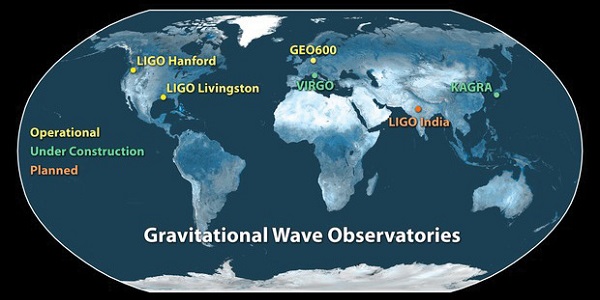 Current operating facilities in the global network include the twin LIGO detectors - in Hanford, Washington, and Livingston, Louisiana, - and GEO600 in Germany. The Virgo detector in Italy and the Kamioka Gravitational Wave Detector (KAGRA) in Japan are undergoing upgrades and are expected to begin operations in 2016 and 2018, respectively. A sixth observatory is being planned in India. Having more gravitational-wave observatories around the globe helps scientists pin down the locations and sources of gravitational waves coming from space.
Current operating facilities in the global network include the twin LIGO detectors - in Hanford, Washington, and Livingston, Louisiana, - and GEO600 in Germany. The Virgo detector in Italy and the Kamioka Gravitational Wave Detector (KAGRA) in Japan are undergoing upgrades and are expected to begin operations in 2016 and 2018, respectively. A sixth observatory is being planned in India. Having more gravitational-wave observatories around the globe helps scientists pin down the locations and sources of gravitational waves coming from space.
The ‘detector characterisation’ team is responsible for monitoring a vast array of environmental data recorded at both sites, that might otherwise affect the detector by creating a signal that is not due to an astrophysical source. One of the main reasons why LIGO has two detectors is to distinguish between ‘normal’ background noise and an astrophysical signal. A real signal would be detected in both detectors with a few milliseconds delay between the two sites, whereas an unwanted environmental noise, such as an earthquake, ground motion, temperature variation or instrumental ‘noise’ - such as the vibration of the fibres that allow the suspension of the mirrors - would be specific to a particular detector.
A real signal and properties
On 14 September 2015 at 09:50:45 Greenwich Mean Time the LIGO Hanford and Livingston Observatories both detected a signal from GW150914. Only three minutes after receiving the signal, the low-latency search that sent the alert promptly identified the signal as a gravitational wave-like pattern.
Over 0.2 seconds, the signal from event GW150914 was observed to increase in frequency and amplitude from 35 to 150 Hz, where the amplitude reached a maximum at 150 Hz. Spurious environmental signals could be ruled out as these all peak at different amplitudes. The gravitational wave strain signal was promptly compared with a database of thousands of signals that have been theoretically predicted, in a process known as matched filtering, to confirm that it was indeed a real gravitational wave coming from the merger of two black holes.
The signal of the gravitational wave is divided into three distinct parts that can be used with different techniques to calculate (and confirm) the wave. The first method, called inspiral, is calculated using post-Newtonian theory. It uses Newton’s laws, and step-by-step adds in different hypotheses to take into account general relativity.
The merger method uses numerical relativity; these are simulations of the full equations of general relativity and, due to the computational power required to solve them, have only been used in the last 10 years.
While the phenomena that produce these waves are generally so massive they are beyond our imagining, the signal they produce is extraordinarily small
The final technique is called ringdown, which corresponds to changes in the resulting single black hole and can be calculated by using the black hole perturbation theory. In total 50 million CPU hours were used to work on this event, which corresponds to 20,000 PCs running for 100 days!
To estimate the accuracy of the received signal, it was important to establish if this signal could have appeared by chance in both of the detectors due to some rare fluctuation. Using 16 days of high quality, stable strain data, a series of artificial time shifts were introduced to create a much longer data set.
These time shifts were generated to be longer than 10 milliseconds to ensure that it could not be confused with a real signal but would only be coincident in noise. From this artificial data set, it was estimated how often a coincident signal mimicking that of GW150914 would appear. This is known as the false alarm rate and the calculated result showed that for a strong event such as GW150914 to appear by chance the likelihood of it happening was only once in about 200,000 years of collected data.
Merging black holes
GW150914 is produced by the coalescence of two black holes with masses of about 36 times and 29 times the mass of the Sun. The post-merger black hole has a mass of about 62 times the Sun’s mass. Properties such as these can be constructed from the strain of the signal, depicted in Figure 4. This image shows the agreement between the reconstruction of the gravitational wave strain in the Hanford detector (blue) and the computed signal using General Relativity (red). Then, the characteristics of the event can be extracted: the masses of the two black holes before the merger, the mass of the single post-merger black hole, and the distance to the event as determined by the amplitude of the signal.
Some 50 million CPU hours were used to work on this event - which corresponds to 20,000 PCs running for 100 days!
So how far away, is far away? “So far away that the signal took 1.3 billions years to reach Earth. These two black holes merged when multicellular on Earth was just starting,” says Gabriela Gonzalez, spokesperson of the LIGO collaboration. The difference between the sum of the masses during the inspiral phase and the mass of the final black hole during the ringdown indicates that the coalescence converted about three times the mass of the Sun into gravitational wave energy in a fraction of a second. This is the most powerful event ever observed, which is more than 10 times greater than the combined luminosity of every star and galaxy in the observable universe.
Without the improved sensitivity of LIGO made in recent years, including the addition of more powerful lasers and using silica fibres on the test masses to reduce thermal noise, it may have been much later before the groundbreaking achievement of detecting gravitational waves was realised.
“I like to think of the two LIGO detectors like two ears,” explains Prof Laura Cadonati, chair of the Data Analysis Council in the LIGO collaboration. “When the gravitational waves signal arrives, the delay between the arrival time in one detector and the other detector can be used to establish where the signal is coming from, just like the delay in a soundwave hitting one of our ears before the other, allowing us to understand where the sound is coming from.” Thus the position of these two black holes merging was estimated thanks to the delay of 7 ms that it took the gravitational waves to reach Hanford after being first detected by Livingston.
Another interesting parameter extracted from the data is that the final black hole associated with GW150914 is spinning. Rotating black holes were predicted theoretically in 1963 by Roy Kerr, a skilled mathematician who discovered the Kerr geometry, an exact solution to the Einstein field equation of general relativity. In general relativity, the end product of a black hole binary merger is a Kerr black hole, which is fully described by its mass and spin. The huge velocity of these merging black holes, where GW150914 originates from, starting at more than 60 per cent of the speed of light, coupled with the tiny separation of the two objects (just a few times that of the Schwarzchild radius), is further proof that GW150914 is due to a binary black hole merger.
Future research
We have reached a new step in astrophysics with the very first detection of gravitational waves. Without the improved sensitivity of LIGO made in recent years, including the addition of more powerful lasers and using silica fibres on the test masses to reduce thermal noise for example, this ground-breaking achievement would not have been realised.
A planned shut down of LIGO was initiated in January to improve functionality and instrument sensitivity. The data acquired from this first run is still in the process of being analysed; however, a second observational run of LIGO is due in the middle of 2016. It should be joined around this time by the French-Italian Advanced Virgo detector. The current location (on the sky) for GW150914 is resolved to an area of approximately 600 square degrees. The addition of this third detector will allow a triangulation of the signal thus substantially reducing this error margin.
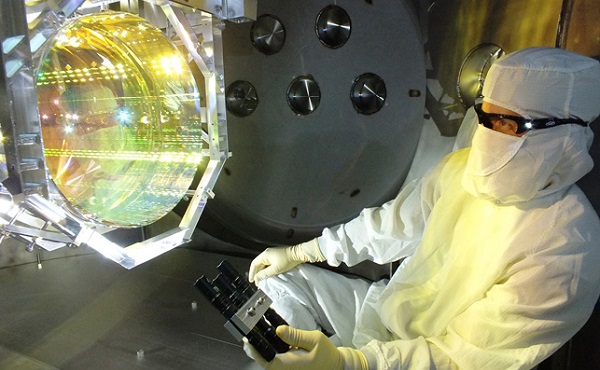 AA technician tests one of the suspended mirrors of the Advanced LIGO detector at Livingston, Louisiana
AA technician tests one of the suspended mirrors of the Advanced LIGO detector at Livingston, Louisiana
It is an exciting time for astrophysics, with a new open field where everything becomes possible. We will have the chance to understand more about black holes thanks to gravitational waves and maybe soon we will be able to detect the signal coming from the coalescence of two neutron stars, or a neutron with a black hole. With it, we might be able to observe gamma ray light emitted from a short gamma ray burst. If so, it will be the first detection between gravitational waves and its coincident electromagnetic emission. The universe has finally delivered its first symphony and we are impatient to hear the second opus.





